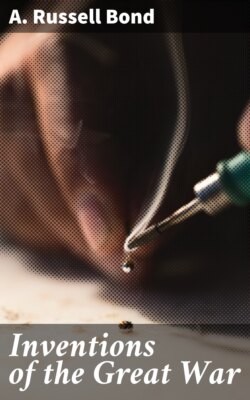Читать книгу Inventions of the Great War - A. Russell Bond - Страница 12
На сайте Литреса книга снята с продажи.
CHAPTER II
Hand-Grenades and Trench Mortars
ОглавлениеTable of Contents
In primitive times battles were fought hand-to-hand. The first implements of war were clubs and spears and battle-axes, all intended for fighting at close quarters. The bow and arrow enabled men to fight at a distance, but shields and armor were so effective a defense that it was only by hand-to-hand fighting that a brave enemy could be defeated. Even the invention of gunpowder did not separate the combatants permanently, for although it was possible to hurl missiles at a great distance, cannon were so slow in their action that the enemy could rush them between shots. Shoulder firearms also were comparatively slow in the early days, and liable to miss fire, and it was not until the automatic rifle of recent years was fully developed that soldiers learned to keep their distance.
When the great European war started, military authorities had come to look upon war at close quarters as something relegated to bygone days. Even the bayonet was beginning to be thought of little use. Rifles could be charged and fired so rapidly and machine-guns could play such a rapid tattoo of bullets, that it seemed impossible for men to come near enough for hand-to-hand fighting, except at a fearful cost of life. In developing the rifle, every effort was made to increase its range so that it could be used with accuracy at a distance of a thousand yards and more. But when the Germans, after their retreat in the First Battle of the Marne, dug themselves in behind the Aisne, and the French and British too found it necessary to seek shelter from machine-gun and rifle fire by burrowing into the ground, it became apparent that while rifles and machine-guns could drive the fighting into the ground, they were of little value in continuing the fight after the opposing sides had buried themselves. The trenches were carried close to one another, in some instances being so close that the soldiers could actually hear the conversation of their opponents across the intervening gap. Under such conditions long-distance firearms were of very little practical value. What was needed was a short-distance gun which would get down into the enemy trenches. To be sure, the trenches could be shelled, but the shelling had to be conducted from a considerable distance, where the artillery would be immune to attack, and it was impossible to give a trench the particular and individual attention which it would receive at the hands of men attacking it at close quarters.
Before we go any farther we must learn the meaning of the word "trajectory." No bullet or shell travels in a straight line. As soon as it leaves the muzzle of the gun, it begins to fall, and its course through the air is a vertical curve that brings it eventually down to the ground. This curve is called the "trajectory." No gun is pointed directly at a target, but above it, so as to allow for the pull of gravity. The faster the bullet travels, the flatter is this curve or trajectory, because there is less time for it to fall before it reaches its target. Modern rifles fire their missiles at so high a speed that the bullets have a very flat trajectory. But in trench warfare a flat trajectory was not desired. What was the use of a missile that traveled in a nearly straight line, when the object to be hit was hiding in the ground? Trench fighting called for a missile that had a very high trajectory, so that it would drop right into the enemy trench.
